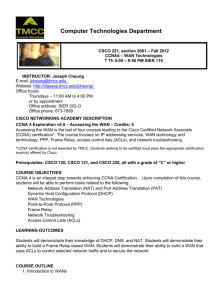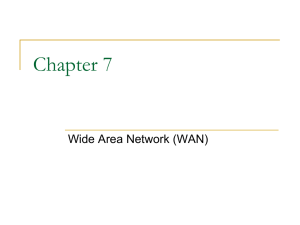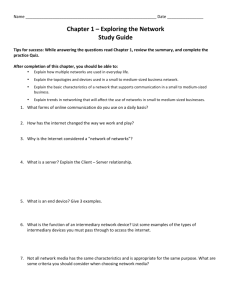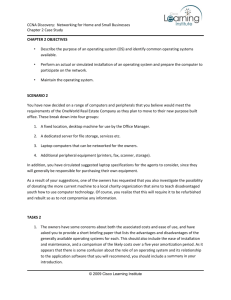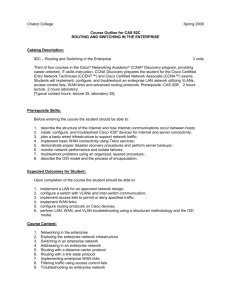CCNA 4: WAN Technologies
advertisement
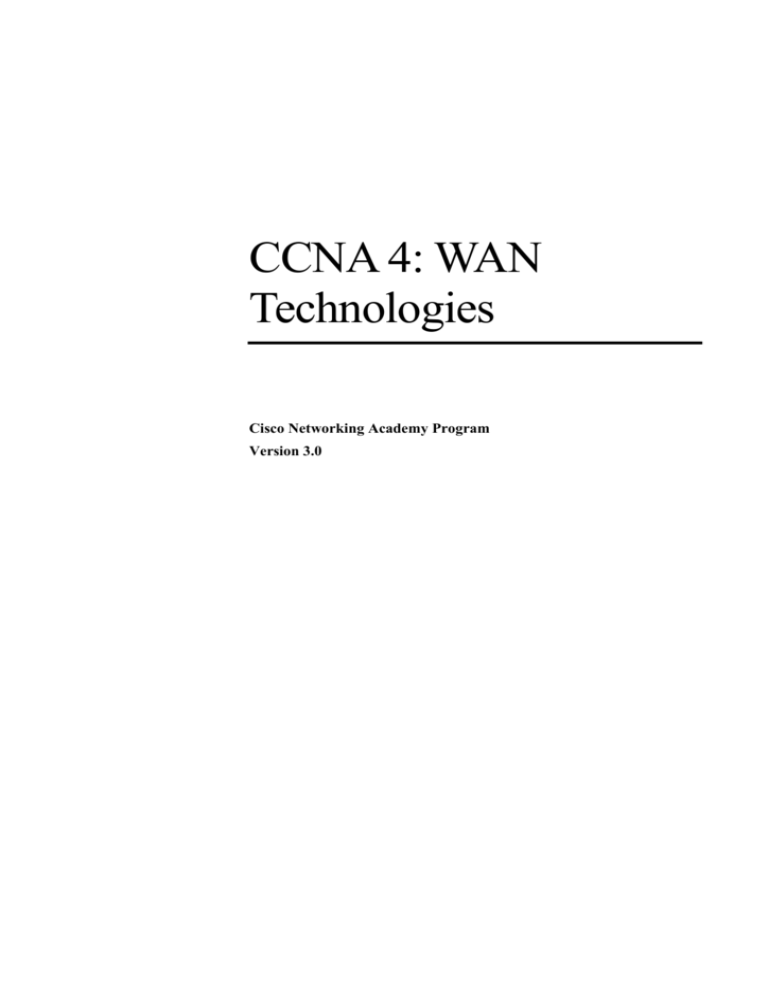
CCNA 4: WAN Technologies Cisco Networking Academy Program Version 3.0 Table of Contents CCNA 4: WAN TECHNOLOGIES ................................................................................................................1 TARGET AUDIENCE .........................................................................................................................................3 PREREQUISITES ...............................................................................................................................................3 COURSE DESCRIPTION ....................................................................................................................................3 COURSE OBJECTIVES ......................................................................................................................................3 COURSE OVERVIEW ........................................................................................................................................4 COURSE OUTLINE ...........................................................................................................................................5 Module 1. Scaling IP Addresses ..........................................................................................................5 Module 2. WAN Technologies .............................................................................................................5 Module 3. PPP.....................................................................................................................................6 Module 4. ISDN and DDR ...................................................................................................................7 Module 5. Frame Relay .......................................................................................................................7 Module 6. Introduction to Network Administration.............................................................................8 Module 7. Emerging Technologies ......................................................................................................9 Case Study: WANs......................................................................................................................................9 Appendix: Preparation for Certification Exam ..........................................................................................9 2 CCNA 4: WAN Technologies v3.0 Copyright 2003, Cisco Systems, Inc. Target Audience Anyone desires a practical, technical introduction to the field of networking. High-school, community college, and lifelong-learning students interested in careers as network technicians, network engineers, network administrators, and network help-desk staff. Prerequisites ■ Students should have Reading Age Level (RAL) of 13. ■ Successful completion of CCNA 3. Course Description CCNA 4: WAN Technologies is the last of four courses leading to the Cisco Certified Network Associate (CCNA) designation. The course focuses on advanced IP addressing techniques (Network Address Translation [NAT], Port Address Translation [PAT], and DHCP), WAN technology and terminology, PPP, ISDN, DDR, Frame Relay, network management, and introduction to optical networking. Particular emphasis is given to students being able to demonstrate the ability to apply knowledge from CCNA 1, CCNA 2, and CCNA 3 to a network and to be able to explain how and why a particular strategy is employed. In addition, the student will prepare for taking the CCNA Exam. Course Objectives The CCNA certification indicates knowledge of networking for the small-office, home-office (SOHO) market and the ability to work in small businesses or organizations whose networks have fewer than 100 nodes. A CCNA certified individual can: ■ Install and configure Cisco switches and routers in multiprotocol internetworks using LAN and WAN interfaces ■ Provide Level 1 troubleshooting service ■ Improve network performance and security ■ Perform entry-level tasks in the planning, design, installation, operation and troubleshooting of Ethernet, TCP/IP Networks. CCNA 4 is an integral step towards achieving CCNA Certification. Upon completion of this course, students will be able to perform tasks related to: ■ 3 Network Address Translation (NAT) and Port Address Translation (PAT) CCNA 4: WAN Technologies v3.0 Copyright 2003, Cisco Systems, Inc. ■ Dynamic Host Configuration Protocol (DHCP) ■ WAN Technologies ■ Point-to-Point Protocol (PPP) ■ Integrated Services Digital Network (ISDN) ■ Dial-on-Demand Routing (DDR) ■ Frame Relay ■ Network Management ■ Optical Networking Course Overview The course has been designed for 70 contact hours. Approximately 35 hours will be designated to lab activities and 35 hours on curriculum content. A case study on structured cabling is required, but format and timing are determined by the Local Academy. What has changed from CCNA versions 2.x? ■ Removal of Net Plus and TCS Chapters ■ Case study required; format and timing determined by Local Academy ■ ■ Addition of Emerging Technologies Module ■ Revision of Network Management Materials ■ More interactive Flash activities ■ Sequence of > 40 eLabs ■ 4 Addition of More WAN Terminology (especially Cable Modem and Broadband) Lab focus on hands-on labs; more eLab support for Academies without Adtrans CCNA 4: WAN Technologies v3.0 Copyright 2003, Cisco Systems, Inc. Course Outline Module 1. Scaling IP Addresses Overview 1.1 Scaling networks with NAT and PAT 1.1.1 Private addressing 1.1.2 Introducing NAT and PAT 1.1.3 Major NAT and PAT features 1.1.4 Configuring NAT and PAT 1.1.5 Verifying PAT configuration 1.1.6 Troubleshooting the NAT and PAT configuration 1.1.7 Issues with NAT 1.2 DHCP 1.2.1 Introducing DHCP 1.2.2 BootP and DHCP differences 1.2.3 Major DHCP features 1.2.4 DHCP operation 1.2.5 Configuring DHCP 1.2.6 Verifying DHCP operation 1.2.7 Troubleshooting DHCP 1.2.8 DHCP Relay Summary Module 2. WAN Technologies Overview 2.1 WAN Technologies Overview 2.1.1 WAN technology 2.1.2 WAN devices 2.1.3 WAN standards 2.1.4 WAN encapsulation 2.1.5 Packet and circuit switching 2.1.6 WAN link options 2.2 WAN Technologies 5 CCNA 4: WAN Technologies v3.0 2.2.1 Analog dialup 2.2.2 ISDN dialup Copyright 2003, Cisco Systems, Inc. 2.2.3 Leased line 2.2.4 X.25 2.2.5 Frame Relay 2.2.6 ATM 2.2.7 DSL 2.2.8 Cable modem 2.3 WAN Design 2.3.1 WAN communication 2.3.2 Steps in WAN design 2.3.3 How to identify and select networking capabilities 2.3.4 Three-layer design model 2.3.5 Other layered design models 2.3.6 Other WAN design considerations Summary Module 3. PPP Overview 3.1 Serial Point-to-Point Links 3.1.1 Introduction to serial communication 3.1.2 Time-division multiplexing 3.1.3 Demarcation point 3.1.4 DTE-DCE 3.1.5 HDLC encapsulation 3.1.6 Configuring HDLC encapsulation 3.1.7 Troubleshooting a serial interface 3.2 PPP 3.2.1 PPP layered architecture 3.2.2 Establishing a PPP session 3.2.3 PPP authentication protocols 3.2.4 Password Authentication Protocol (PAP) 3.2.5 Challenge Handshake Authentication Protocol (CHAP) 3.2.6 PPP encapsulation and authentication process 3.3 PPP Configuration 6 CCNA 4: WAN Technologies v3.0 3.3.1 Introduction to configuring PPP 3.3.2 Configuring PPP Copyright 2003, Cisco Systems, Inc. 3.3.3 Configuring PPP authentication 3.3.4 Verifying the serial PPP encapsulation configuration 3.3.5 Troubleshooting the serial PPP encapsulation configuration Summary Module 4. ISDN and DDR Overview 4.1 ISDN Concepts 4.1.1 Introducing ISDN 4.1.2 ISDN standards and access methods 4.1.3 ISDN 3-layer model and protocols 4.1.4 ISDN functions 4.1.5 ISDN reference points 4.1.6 Determining the router ISDN interface 4.1.7 ISDN switch types 4.2 ISDN Configuration 4.2.1 Configuring ISDN BRI 4.2.2 Configuring ISDN PRI 4.2.3 Verifying the ISDN configuration 4.2.4 Troubleshooting the ISDN configuration 4.3 DDR Configuration 4.3.1 DDR operation 4.3.2 Configuring legacy DDR 4.3.3 Defining static routes for DDR 4.3.4 Specifying interesting traffic for DDR 4.3.5 Configuring DDR dialer information 4.3.6 Dialer profiles 4.3.7 Configuring dialer profiles 4.3.8 Verifying DDR configuration 4.3.9 Troubleshooting the DDR configuration Summary Module 5. Frame Relay Overview 7 CCNA 4: WAN Technologies v3.0 Copyright 2003, Cisco Systems, Inc. 5.1 Frame Relay Concepts 5.1.1 Introducing Frame Relay 5.1.2 Frame Relay terminology 5.1.3 Frame Relay stack layered support 5.1.4 Frame Relay nandwidth and flow control 5.1.5 Frame Relay address mapping/topology 5.1.6 Frame Relay LMI 5.1.7 Stages of Inverse ARP and LMI operation 5.2 Basic Frame Relay Configuration 5.2.1 Configuring basic Frame Relay 5.2.2 Configuring a static Frame Relay map 5.2.3 Reachibility issues with routing updates in NBMA 5.2.4 Frame Relay subinterfaces 5.2.5 Configuring Frame Relay ssubinterfaces 5.2.6 Verifying the Frame Relay configuration 5.2.7 Troubleshooting the Frame Relay configuration Summary Module 6. Introduction to Network Administration Overview 6.1 Workstations and Servers 6.1.1 Workstations 6.1.2 Servers 6.1.3 Client-server relationship 6.1.4 Introduction to NOS 6.1.5 Microsoft NT, 2000, and .NET 6.1.6 UNIX (SUN, HP, LINUX) 6.1.7 Apple 6.1.8 Concept of service on servers 6.2 Network Management 8 CCNA 4: WAN Technologies v3.0 6.2.1 Introduction to network management 6.2.2 OSI and network management model 6.2.3 Standards: SNMP and CMIP 6.2.4 SNMP operation 6.2.5 Structure of management information and MIBs Copyright 2003, Cisco Systems, Inc. 6.2.6 SNMP protocol 6.2.7 Configuring SNMP 6.2.8 RMON 6.2.9 Syslog Summary Module 7. Emerging Technologies Overview 7.1 Basics of Optical Networks 7.1.1 Optical business requirements 7.1.2 Fiber-optic transmission systems 7.1.3 Light 7.1.4 Optical transmission 7.1.5 Reflection and refraction 7.1.6 Optical fibers 7.1.7 Loss factors 7.1.8 Attenuation 7.1.9 Optical filter and amplifier technology 7.2 Optical Transmission and Multiplexing 7.2.1 SONET technology 7.2.2 SONET/SDH 7.2.3 DWDM systems 7.2.4 E/O/E conversion 7.2.5 Data transmission 7.2.6 DWDM advantages Summary Case Study: WANs Appendix: Preparation for Certification Exam 9 CCNA 4: WAN Technologies v3.0 Copyright 2003, Cisco Systems, Inc.
